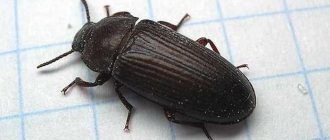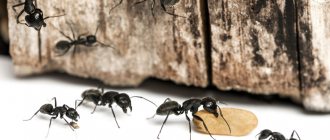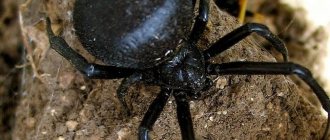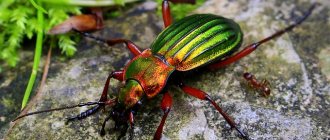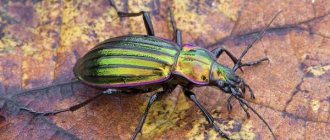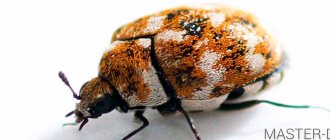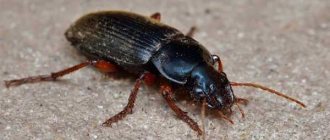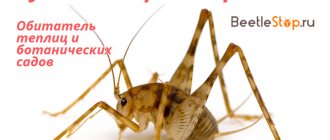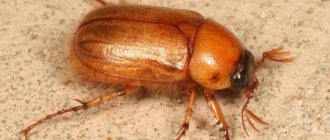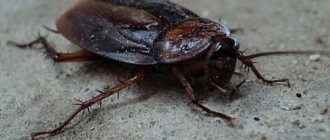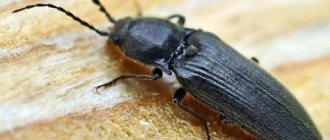Where do bugs come from in an apartment?
When the owners notice that black beetles have appeared in the room, despite the fact that there is no disorder in the room and the cleaning was carried out on time, the question immediately arises where they could come from.
Ways of appearance of beetles in an apartment:
- cracks in walls, window frames, into which small insects can easily crawl;
- ventilation shafts and openings in which protective nets are not installed;
- windows and vents, open for ventilation, can become an “entrance door” through which flying insects fly into the apartment;
- through risers of sewer and water pipes;
- black beetles appear in apartments in the summer, clinging to people’s shoes or clothes, thus penetrating the living rooms and kitchen;
- from a neighboring basement or attic.
What means to fight the grinder in the house
As mentioned earlier, it is not the beetles themselves that cause damage to wood, but their larvae. Therefore, if there is a beetle grinder, the fight should be aimed primarily at destroying the larvae.
Folk remedies in the fight against the grinder:
- The simplest remedy is Vaseline oil. You need to take it into a pipette or syringe and insert it into the holes, then fill them with wax, paraffin or cover them with window putty. The oil is odorless, non-flammable, and does not contain substances that threaten human health. This treatment is especially suitable for bedside tables and cabinets where food is stored. The procedure should be repeated after two weeks. If no new holes appear within a month, then the grinder beetle is defeated.
- A good way to fill the holes with a mixture of three parts turpentine and one part kerosene is to use naphthalene dissolved in gasoline (8g naphthalene, 90g gasoline). Apply the mixture with a brush.
- The fight against the borer is highly effective if you use hot air heating, the temperature should be high up to +60° C. Or, conversely, to destroy the larvae you will need to freeze the temperature below - 2° C, for two days or more.
- Equal parts black carbolic acid, tar and naphthalene. The resulting mixture is used to fill the holes and passages.
Photos and names of black beetles
You can determine exactly what the black beetle in the house is called by its appearance and size, as well as its location. They can settle both in food and in furniture, carpets or wooden structures and walls.
The most common black beetles, which sometimes settle in an apartment or private house, are beetles or flour beetles. They received their second name because they prefer to eat cereals and other bulk products.
In total, there are 3 types of Khrushchak:
- large beetles - differ in their length (up to 13 mm);
- small – have a size of up to 3.6 mm;
- black - distinguished by black color.
Black bugs in the apartment
In addition to the flour beetle, there are other types of small black bugs in the apartment:
- skin beetles - small black insects up to 4 mm in size that feed on fur and leather products, paper from books, indoor plants and food (flour, nuts, cereals, meat, etc.) - live in closets, old clothes, crevices of furniture; dangerous because they can carry infections and helminths;
- carpet beetles - they settle in beds and carpets, feeding on old peeling human skin, hair and crumbs; they can render things unusable and also cause allergies in some people;
- fleas are small jumping parasites that bite painfully and can carry infection; they often appear in homes where cats and dogs live.
How to get rid of it?
As a rule, the appearance of flour pests is noticed when they have already begun to take root in bags of cereals and flour. It will not be possible to get rid of house bugs by preserving contaminated products, since insect eggs will remain in them. Cereals should not be eaten even after calcination. We'll have to throw everything away. But this is not enough. After all, both adult pests and eggs can be found on the walls of kitchen cabinets, behind them and in other places.
Chemicals
The use of chemicals is the fastest and most reliable way to get rid of beetles in an apartment. Aerosols are convenient for targeted use. It is necessary to process not only the cabinets where the food products were located, but also the walls behind them and the baseboards.
To remove bugs, you can also use emulsion concentrates. Dilute them according to the instructions and treat the room with a spray bottle.
When using pesticides, you must not forget about protective measures.
Folk remedies
People have long noticed that small black insects cannot tolerate both low and high temperatures. And if freezing the apartment does not work, then at the dacha this method is quite justified. In an apartment building you can use a steam generator. At high temperatures, not only adults die, but also eggs. Cereals can be calcined in the oven, but if they have been contaminated, then it is useless to do so; you cannot eat them anyway.
Dry bait made from borax, semolina and powdered sugar, placed in small containers in cabinets, will attract pests like a magnet. Once they try it, they won't have long to live.
Mint, lavender, bay leaf, and garlic have repellent properties. Black beetles with wings do not like these smells and will try to leave the apartment. You can use not only plants, but also essential oils, which are applied to cotton pads and placed in kitchen cabinets.
Recommendations for fighting
When starting to fight black insects in an apartment, you first need to get rid of all contaminated products and those that cause suspicion. After that:
- The remaining cereals are calcined in the oven at a temperature of 180–2000C for 15 minutes. The remaining products are placed in the freezer.
- All cabinets and table surfaces are washed with diluted vinegar, citric acid or bleach.
Treatment
- The dishes are treated with soap and soda solution.
- Walls, floors, and baseboards must also be thoroughly wiped with water and a disinfectant.
Only in this case can you be sure that after some time a new generation of pests will not appear.
Big Khrushchak
According to the biological classification, Khrushchev beetles belong to the Darkling beetle family, numbering 11 species, of which only 3 are common in Russia and Moscow.
Khrushchak is a large black beetle up to 1.8 cm long, its body is flattened, and there are only 6 legs (3 pairs). The color of the body is black-brown and shiny, the abdomen has a reddish tint. Females lay 200 eggs. into the nest. The pest larva (popularly called a mealworm) is larger in size, up to 2.5 cm, and brownish-yellow in color. It feeds on grain, flour and bran. As the larva grows, it undergoes 4 molts.
The flour beetle chooses as habitats in the apartment those that are located near its favorite food. In nature, they prefer to live in tree hollows or rotten parts. The beetle's main diet consists of animal food (the corpses of small mammals and insects) and plant food.
Important!
When settling in an apartment, beetles look for food in the form of grain, flour, cereals or bran. They spoil food supplies, contaminating them with their excrement, skins from larvae and dead insects. In a short time, black bugs can multiply and infest all your kitchen cabinets and drawers.
Big and small Khrushchak
Lice
Lice in your bed are rare. They spend their entire lives in the hairy part of the head. They are quite clumsy and slow, so any fall from their hair can be fatal for them. They constantly need blood, and once they fall down, it is no longer possible for them to climb to a food source.
As we have already said, they spend their entire lives on the head or pubic area of a person. There are also types of linen, but they are not so common now. They mainly affect homeless people and tramps who do not change or wash their clothes for a long time.
Lice bites are not as painful as those of fleas or bedbugs. But they can also cause a lot of discomfort with their itching.
These parasitic insects are removed with lice shampoos and sprays. At the same time, it is important to constantly comb them with a special fine-toothed comb.
Review
My daughter has very long thick hair. When she went to second grade, she accidentally caught lice from someone. When I remember how many times I took these parasites out of my head, it becomes scary. I probably bought different products five times, but in the end the lice shampoo helped. But I still had to part with my long hair. It's a pity, but what will you do? After that, apparently out of habit, I check her head almost every evening.
Elena, Arzamas
Small Khrushchak
The small flour beetle has a brown or red body color and causes considerable damage to the food supply of a person in an apartment. It is widespread in Russia and Ukraine, where it often causes spoilage of grain in granaries, mills and other places where bulk products are stored.
The red-brown beetle is smaller in size (up to 3.6 mm), but it loves to settle in various food supplies in the apartment: flour, nuts, dried fruits and other plant fruits.
On a note!
Unlike the large Khrushchak, the small one has wings and is able to fly. The males of such a flying insect have an abdomen rounded at the end and covered with hairs. In females, the tip of the body is bare; they are capable of laying up to 1 thousand eggs.
The larva of the small beetle has a flat shape and a length of up to 7 mm, the body color is yellow-brown (light or dark shades), the head is flattened. The body is covered with hairs and ends with 2 spines. The pupa is painted light yellow, and its body is shiny and completely naked. The development cycle of the flying black beetle is 20-120 days, and the growth rate directly depends on the amount of food and living conditions.
What are the consequences of a bug bite
Like most bites, bug bites are simply reddish spots on the skin with a mark from the inserted proboscis. Most often, the bug leaves a peculiar series of such bites (3-7 pieces each). If you spot such a path on your body, you know that bedbugs are biting you!
If there is a large infection or a person is sensitive to its bites, an allergy may develop. This puts children at risk of developing anemia. The rashes from the bites are too profuse, and in some cases they can fester. This causes a lot of discomfort.
Bed bugs are clear carriers of many infectious diseases through their bites, but there are no recorded cases of transmission of hepatitis and HIV infection.
Black Khrushchak
The 3rd type of beetle has a darker, almost black body color, the size of which is up to 5.5 mm. Their body color is matte, the color varies from black to brown.
Unlike other species, small black beetles prefer to live only in heated rooms. By settling in the kitchens of people's houses and apartments, they are capable of ruining not only food products, but also glue, fabrics (knitwear and nylon) and other products. They are found much less frequently than their large and small counterparts. The larvae grow to a size of 12 mm.
Important!
However, once settled in an apartment, a colony of Khrushchak insects can cause a lot of harm. By feeding on the excrement of other pests (mice and rats), they can become carriers of infections and worms.
Black Khrushchak
Place of the cockroach among other beetles
All beetles undergo complete metamorphosis throughout their lives: the nymph of a beetle does not resemble an adult insect.
You can tell an insect is a beetle if its outer pair of wings are “elytras” that protect the flying wings below. Beetles belong to the order Coleoptera. If the insect has hard, shield-like wings, it is a beetle.
Cockroaches, along with termites, are in the order Blattodea. The data varies, some researchers count at least 5,000 species of cockroaches, among which there is even such an exotic as the hairy cockroach. This species undergoes incomplete metamorphosis, which means that the small cockroach looks exactly the same as the adult, but it is smaller and wingless. Cockroaches have two pairs of wings, and the top pair will be leathery, but not hard, like a beetle's wing.
You can usually also tell that it's a cockroach if the head is barely visible from above: cockroaches usually hide their heads under an enlarged "pronotum." For example, with giant hissing cockroaches (which have no wings), you can't see their heads at all, only their antennae peeking out.
Cockroaches and beetles can be easily distinguished by the appearance of their wings. The beetle's elytra are symmetrically located in the middle, and the wing veins are straight and parallel. In contrast, cockroaches' wings fold toward each other, and the wing veins branch or are shaped like leaves.
Cockroaches rarely bite, but beetles can cause some damage to humans with their massive mouthparts, usually when they feel threatened.
Methods to combat bugs
If black beetles appear in the apartment, then first you should determine their type based on external signs.
Depending on the identification, you can use various control methods to help get rid of black beetles:
- Carpet beetles and carpet pests should be combated by treating carpets and furniture; first they must be wiped with a sponge soaked in a soap solution, and then with a vinegar solution; a day after treatment, carpets and furniture should be vacuumed well, and the contents of the bag should be thrown away, as there may be insect eggs in there;
- to destroy flour beetles, it is necessary to carefully sort through all reserves of bulk products (flour, cereals, sugar, etc.); if they are found, everything must be thrown away, because they are not suitable for consumption;
- inspect the contents of all cabinets for small black or red bugs, then make a solution of 1 tbsp. l. soda per 1 liter of water and treat all surfaces and shelves inside the cabinets, wash the dishes using detergents and pour boiling water over them;
- wash all surfaces in the kitchen with a solution of acetic acid or use boric acid powder, which should be rubbed into areas where parasites may live;
- treat the floor covering and baseboards with any aerosol containing an insecticide against insects (Dichlorvos, Combat, Raid, etc.);
- clothes should be boiled or washed in hot water (not lower than +60°C).
On a note!
The procedure for exterminating insects should be repeated 2 times a week for a month, since new generations of bugs will hatch from the laid eggs of insects, which also need to be destroyed.
If the measures taken do not help or there is no time to fight bugs in the apartment for a long time, then it is better to turn to professionals. There are companies that use special preparations to carry out disinfestation (extermination of pests) in any residential premises.
Fighting bugs in the house
Insect prevention measures
High-quality and regular cleaning is considered the best preventive measure against any insects.
This is especially true for the kitchen:
- It is better to keep all dry cereals, flour, sugar and other crumbly products in closed containers.
- Along the entire perimeter of the kitchen and in closets with clothes, you can hide special lavender tablets that will repel beetles.
- To ensure that beetles do not appear, you can periodically wash all kitchen surfaces with a solution of water and vinegar, soda or citric acid.
- Of course, you will have to take care of the cracks and the presence of screens on the windows.
Bark beetles and other inhabitants of wooden houses
In addition to the above beetles that settle in apartments, there are also specific species that live in a wooden house. Most often, insects enter the house along with contaminated building materials and pose a great danger to all wooden structures and furniture. They are capable of not only destroying valuable property in a short time, but also turning all the walls and structures of a building into dust.
They differ in that their main food is wood:
- bark beetles - a large group of beetles (750 species), the size of the insect is 5-10 mm, in the forest bark beetles carry out sanitary work, destroying rotten trees, and in a wooden house they are considered pests, they gnaw long passages in the wood and destroy it, insect larvae are capable of in a few years “eat” the whole house;
- grinders are long, oblong small bugs, 2-10 mm in size, black or brown in color, they are coleopteran insects, dangerous for wooden structures, furniture, books and cardboard, they also feed on grain reserves, making characteristic ticking sounds; at the slightest danger they pretend to be dead, black beetles are active in the house at night and can only be identified by rustling and other sounds;
- longhorned beetles are larger pests (up to 35 mm in size) of black, brown or blue-green color, with large mustaches (10 times longer than the body), the larvae are large, up to 3 cm in size, capable of damaging a wooden frame in a private house, transforming structures to complete ruin in a relatively short period of time, they prefer to settle in coniferous wood (in partitions, floors, on the roof, etc.).
Bark beetles
Interesting!
All beetles that chew on wooden walls or furniture in the house make a characteristic sound, similar to the ticking of a mechanical watch. In the old days, such parasites were called “death clocks”, due to the fact that their activity often led to the collapse of wooden houses and the death of their inhabitants.
The development of beetles that feed on wood follows the same pattern. Females lay eggs in crevices, from which larvae hatch and gnaw into wood walls. They gnaw passages in it and spoil the appearance and structure of wooden walls and ceilings. After the larvae transform into pupae, adults crawl to the surface.
Beetle grinder in the house - why it is dangerous
Carpenter beetles not only live in wooden structures, but also eat them. The ideal home for insects is wooden log houses. Lumber stored in stacks, especially logs and beams, are also attractive to them. Furniture can be eaten away by larvae to such an extent that at the slightest contact it crumbles into dust, the same applies to beams and ceilings.
The beetles are shy and are active mainly at night. It is not easy to see them, let alone catch them; when danger arises, the grinder pretends to be dead, so it is easy to mistake it for ordinary rubbish, and not at all for a living creature.
Insects similar to cockroaches
If you find tiny black beetles crawling around your home, don't panic. If you and your pets are not suffering from bites, the pests are probably not bed bugs or fleas.
Carpet beetles
An adult bug will not harm your home. Unfortunately, the same cannot be said about their larvae. Carpet beetle larvae can eat holes in rugs, curtains, upholstery, clothing and books. You may not even know you have an infestation until you notice the damage caused by pests. If you notice anything suspicious, roll up your sleeves and clean it. Thoroughly clean out the dust and cobwebs that protect these pests. Then take the clothes out of the closet and wash everything or send it to the dry cleaner. Finally, treat your carpets with an insecticide, boric acid, or diatomaceous earth to kill any remaining larvae.
Although carpet beetles may eat wool, silk, or flakes, they do not bite and will not cause structural damage to your home. If they leave a black or brown smear when crushed, you most likely have carpet beetles.
They feed on carpets and similar foods and reproduce slowly.
Carpet beetles are only 2-3 millimeters long - about the size of a pinhead - and vary in color. Some are black or dark enough to appear black when observed by the human eye. Others may be spotted, with brown and black spots on a lighter background. Like many other beetles, they are round or oval and convex, like ladybugs. Carpet beetles are covered in tiny hairs that are difficult to see unless you look at them under magnification.
Carpet beetle larvae are elongated and appear fuzzy or hairy. They leave behind their shed skins so you may find them in infested pantries, cupboards or drawers.
stink bugs
These aliens usually live and breed outdoors, but when temperatures get cooler, they often make their way indoors to hibernate. If you see these shield bugs in your home, do not try to hit or squash them. When disturbed, stink bugs live up to their name by emitting a foul odor that only attracts more stink bugs. Try removing them with a vacuum cleaner. The only catch is that when you're done, you'll have to remove the vacuum bag and dispose of it a safe distance from your home.
Ants
Tiny but merciless home invaders. They enter your home in search of food, water and shelter, which means your kitchen and bathroom are their prime targets. Although baited traps are very effective at killing ants, they are not entirely safe for use in areas where small children or pets may enter.
If you don't want to use traditional poisons, there are a number of natural remedies you can try. Once you've managed to get rid of these pests, discourage them from coming back by vacuuming regularly, wiping down surfaces every day to remove their scent, and taking out the trash every day.
Sewer flies
Drain flies live deep in sticky, murky drains. The reason you find drain flies in your sink or shower is because they feed and lay eggs in the decaying debris that lines clogged drains. If you notice drain flies buzzing around your sink, you need to correct the situation immediately. First, determine which drain they are coming from.
Most likely, there is a blockage in this drain. You will need to clean it before you can get rid of the unpleasant neighborhood. Use a drain brush to clear out any accumulated mucus, then open the drain under the sink to remove any remaining clog. Close the system again and finish by pouring the enzyme cleaner down the drain to remove residue and any remaining fly eggs.
Shimmering and sliding silver
Another insect you never want to see indoors. This pest will feed on fabric, paper, glue and cardboard boxes. Silverfish are such an ancient creature that they even predate dinosaurs. Therefore, it is difficult to drive them out of the house once they are there. However, you can get rid of them using traps, insecticides, or natural substances such as boric acid or diatomaceous earth.
To make sure the silverfish are driven away, make a few small changes to make your home less hospitable to them. Remove folded newspapers, junk mail and old cardboard boxes. Store out-of-season clothing and supplies in plastic containers, and remove your dry goods from boxes and store them in containers with tight-fitting lids.
Mole
Fruit moths like to feed on foods such as flour, beans and dried fruits. They also eat pet food, and even Christmas decorations. These moths do not carry disease, so you can eat the food after you remove the carcasses and freeze the food for at least four days. But it is better to use durable containers with airtight lids.
Crickets
Some types of crickets can bite if provoked. However, these creatures rarely bite. They need to be collected, say, with gloves, and thrown away.
Mosquitoes and mosquitoes
Worldwide, mosquito-borne diseases kill more people than any other cause. Mosquitoes can spread various types of encephalitis and can transmit parasites to pets such as dogs and cats.
Fleas
If your pets bring fleas into your home, you will know about it. These pests may be small, but they jump and bite a lot, especially during the warmer months. The best form of prevention is to protect your pets from fleas.
Spiders
Spiders often come indoors in search of warmth and food. We all know that they prey on other insects, which can be beneficial, but do you really want to share your home with them? You can get rid of spiders with a little patience and the right tactics - but act quickly before they have a chance to lay eggs!
flies
Not only are flies a nuisance, they can also carry diseases and pose a health hazard if left untreated. So, if you are experiencing constant annoying flies, it is time to take care of their extermination.
Termites
Termites can cause serious damage to your home. This is a particularly dangerous pest that is notoriously difficult to get rid of. If you notice any of these wood-chewing creatures or signs of their activity, it is important to deal with them immediately!
Bed bugs
Before you can do anything to prevent a bed bug infestation, you need to determine what the pest looks like and where it likes to hide. Bed bugs have small, flat, oval bodies that are wingless and brown in color.
They hide in mattresses, bed frames, bedding, furniture, carpets, and baseboards. If you already have a bedbug infestation in your home, check out our guide to learn how to get rid of it. Or learn how to prevent an infection before it starts.
